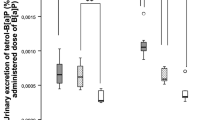Abstract
LD50 values for 1,2,3,4-, 1,2,4,5- and 1,2,3,5-tetrachloro- benzene (TCB) were found to be 1470, 3105 and 2297 mg·kg-1, respectively, in male rats. In females the LD50 values were found to be 1167 and 1727 mg·kg-1 for 1,2,3,4- and 1,2,3,5-TCB, respectively. Clinical signs of toxicity included depression, flaccid muscle tone, prostration, piloerection, loose stool, hypothermia, dacryorrhea, coma and death. In a subacute study, rats were fed diets containing 0, 0.5, 5.0, 50 or 500 ppm 1,2,3,4-, 1,2,4,5- or 1,2,3,5-TCB for 28 days. At 500 ppm 1,2,4,5-, but not 1,2,3,4- or 1,2,3,5-TCB, caused a significant increase in the liver weight, and serum cholesterol of male and female rats. Hepatic microsomal aniline hydroxylase was induced by 500 ppm 1,2,4,5-TCB. Hepatic microsomal aminopyrine demethylase activity was increased by the administration of this compound at 50 ppm and higher in males and at 500 ppm in the females. Rats fed 1,2,3,4- and 1,2,3,5-TCB at 500 ppm also showed a significant increase in aminopyrine demethylase activity. Moderate to severe histological changes were found in the liver, thyroid, kidney and lungs of rats fed 500 ppm 1,2,4,5-TCB. Histological changes in the tissues produced by the administration of the 1,2,3,4- and 1,2,3,5- isomer were mild even at the highest dose levels. Similar results were observed in rats fed TCB isomers for 90 days. However, histopathological changes in the kidney of rats fed 1,2,4,5-TCB were more severe than those of the subacute study. Tissue residue data showed that 1,2,4,5-TCB accumulated in a dose-dependent manner and at much higher concentrations than the other two isomers. In a separate study adult male rats were given orally single doses of 14C-l, 2,3,4-, or 1,2,4,5-TCB at 10 mg·kg-1 body weight, and were housed in individual metabolism cages to collect urine and feces for radio- assay. The fat, skin and liver of rats dosed with 1,2,4,5-TCB contained the highest levels of radioactivity, whereas little 14C was detected in 1,2,3,4- and 1,2,3,5-TCB treated animals. For 1,2,3,4- and 1,2,3,5-TCB, approximately 46% to 51% of the administered compound were excreted in urine and feces within 48 hours after administration. During the same period only 8% of the administered 1,2,4,5- Tetrachlorobenzene was excreted. Analysis of urine indicated that the tetrachlorobenzenes were biotransformed to a number of polar metabolites. The metabolites for each of the three TCB’s in decreasing order of quantities were as follows; for 1,2,3,4-TCB: 2,3,4,5- and tetrachlorophenol and a trace of tetrachlorothiophenol and 2, 3,4-trichlorophenol; for 1,2,3,5-TCB: 2, 3, 4, 6-tetrachlorophenol, isomeric mercaptotrichlorophenols and a trichlorophenol; for 1,2,4,5-TCB: 2,3,5,6-tetrachlorophenol, tetrachloroquinol and a trichlorophenol. Data indicate that 1,2,4,5-TCB was much more toxic than the other two TCB isomers, and that the differences in toxicity were associated with a higher degree of bioaccumulation and slower metabolic degradation of this compound.
Access this chapter
Tax calculation will be finalised at checkout
Purchases are for personal use only
Preview
Unable to display preview. Download preview PDF.
Similar content being viewed by others
References
Ariyoshi, T., Ideguchi, K., Ishizuka, Y., Iwasaki, K. and Arakaki, M. 1975a. Relationship between chemical structure and activity I. Effects of number of chlorinated atoms in chlorinated benzenes on the components of drug-metabolizing system and the hepatic constituents. Chenu Fharm. Bull. 23: 817–823.
Ariyoshi, T., Ideguchi, K., Iwasaki, K. and Arakaki, M. 1975b. Relationship between chemical structure and activity II. Influences of isomers in dichlorobenzene, trichlorobenzene and tetrachlorobenzene on the activities of drug-metabolizing enzymes. Chem. Fharm. Bull. 23: 834–830.
Braun, W.H., Sung, L.Y., Keyes, D.G. and Kociba, R.J. 1978. Pharmacokinetic and toxicological evaluation of dogs fed 1,2,4,5-tetrachlorobenzene in the diet for 2 years. J. Toxicol. Environ. Health 4: 727–734
Burke, M.D. and Mayer, R.T. 1974. Ethoxyresorufin: Direct fluorometric assay of microsomal O-delakylation which is preferentially inducible by 3-methylcholanthrene. Drug Metab. Dispos. 2: 583–588.
Cochin, J. and Axelrod, J. 1959. Biochemical and pharmacological changes in the rat following chronic administration of morphine, nalorphine and normophine. J. Pharmacol. Exp. Therap. 125: 105–110.
Finney, D.J. 1952.Probit Analysis. 2nd ed., Cambridge University Press, Cambridge.
Fomenko, V.N. 1965. Determination of the maximum permissible concentration of tetrachlorobenzene in water basins. Hyg. Sanit. (U.S.S.R.) 30: 8–15.
Fouts, J. R. 1963. Fators influencing the metabolism of drugs in liver microsomes. Ann. N.Y. Acad. Sci. 104: 875–880.
Gornall, A.G., Bardawill, C.J. and David, M.M. 1948. Determination of serum proteins by means of biuret reaction. J. Biol. Chem. 177: 751–755.
Great Lakes Water Quality Board. 1978. Great Lakes Water Quality. Status report on organic and heavy metal contaminants in the Lakes Erie, Michigan, Huron and Superior Basins.International Joint Commission, Windsor, Ontario, pp. 373.
Jerina, D.M. and Daly, J.W. 1974. Arene oxides: A new aspect of drug metabolism. Science 185: 573–582.
Lunde, G. and Ofstad, E.B. 1976. Determination of fat soluble chlorinated compounds in fish. J. Anal. Chem. 282: 395–399.
Schwartz, S. and Wikoff, H.H. 1952. The relation of erythrocyte coproporphyrin and protoporphyrin to erythropoiesis. J. Biol. Chem. 194: 563–573.
Shen, S.Y., Villeneuve, D.C. Chu, I., Kelly, J. and Gilman, A.P. 1983. The acute dermal toxicity of tetrachlorophenols in the rat. Bull. Environ. Contain. Toxicol., in press.
Villeneuve, D.C., Valli, V.E. Chu, I., Secours, V.E., Ritter, L. and Becking, G.C. 1979. Ninety-day toxicity of photomirex in the male rat. Toxicology 12: 235–250.
Yagminas, A.P. and Villeneuve, D.C. 1977. An automated continuous flow assay for serum sorbitol dehydrogenase activity and its use in experimental liver damage. Biochem. Med. 18: 117–125.
Author information
Authors and Affiliations
Editor information
Editors and Affiliations
Rights and permissions
Copyright information
© 1984 D. Reidel Publishing Company
About this paper
Cite this paper
Chu, I., Villeneuve, D.C., Valli, V.E. (1984). Comparative Toxicity and Metabolism of Tetrachlorobenzene Isomers. In: Kaiser, K.L.E. (eds) QSAR in Environmental Toxicology. Springer, Dordrecht. https://doi.org/10.1007/978-94-009-6415-0_3
Download citation
DOI: https://doi.org/10.1007/978-94-009-6415-0_3
Publisher Name: Springer, Dordrecht
Print ISBN: 978-94-009-6417-4
Online ISBN: 978-94-009-6415-0
eBook Packages: Springer Book Archive



